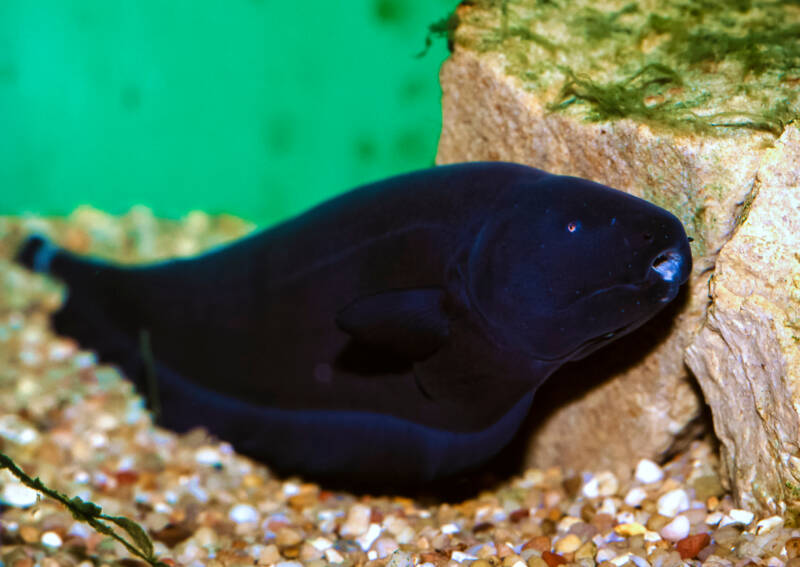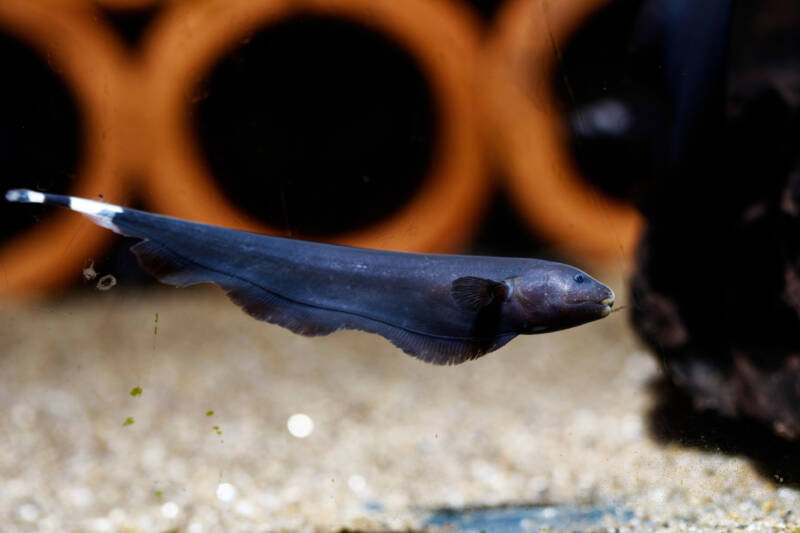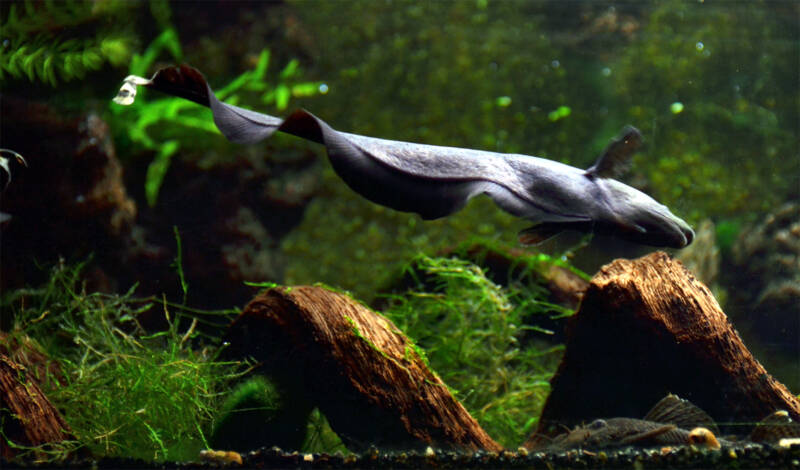Not every freshwater aquarium needs a burst of vibrant color.
Sometimes you want something unusual as the centerpiece of your tank.
And if you want a genuine conversation piece? You couldn’t ask for better than the black ghost knife (Apteronotus albifrons).

Black ghost knifefish don’t attract a ton of attention with their monochromatic color scheme.
But when you start to dive into their biology, you find plenty of unique facts you can share with everyone that drops by for a visit.
Why not discuss the lack of a dorsal or caudal fin? Black ghosts rely on their pectoral and anal fins to generate a fluid, wave-like motion – similar to that seen in a skate or ray.
It’s hypnotic to watch and allows them incredible maneuverability through the water.
Or you could touch on the electrogenesis. Similar to the electric eel, black ghost knifefish can generate and receive electric signals to help them navigate through the murky waters of their native regions.
And the same electric frequencies allow them to communicate with each other.
Of course, as unique as black ghost knifefish are, they’re also not for the faint of heart.
These fish present challenges beyond the scope of the beginner aquarist.
And if you’re not ready to handle such a fish? You may want to admire the species from afar.
At a Glance
| Minimum tank size: | 100 gal (379 l) for ONE |
| Water temperature: | 73-80°F (23-26°C) |
| Avg. lifespan: | 10-15 years |
| Adult size: | 18-20 inches (45-51 cm) |
| School size: | no more than 2; Okay alone |
| pH: | 6.5-8.0 |
| Behavior: | peaceful and active |
| Hardness: | 0-10 dH |
| Ammonia and nitrite: | 0 ppm |
| Nitrate: | <30 ppm |
[toc]
In the Wild

You’ll find the black ghost knife in Argentina, Brazil, Paraguay, and Venezuela.
In particular, they frequent the river systems of the Paraguay and Paraná.
During the dry season, they stick to faster rivers and streams. But they head into the flooded forests during the rainy season.
Those waters come complete with heavy vegetation. That means plenty of obstacles – and not much in the way of light.
Of course, black ghosts are nocturnal. And they don’t rely on the moon or stars filtering down through the greenery, anyway. They have a better system.
Clustered along the skin of the tail, black ghost knifefish possess specialized cells capable of electric organ discharge (EOD).
The electricity generated allows for electrolocation – navigation via an electric field.
It’s how the species “sees” in the murky, plant-filled waters.
But in the black ghost knife, the EOD plays another role. No, it can’t stun their prey (you’re thinking of the electric eel).
The fish control the frequency of the signal. And this allows them to recognize and communicate with each other.
Females produce a higher frequency than males. This allows potential mates to locate one another through the choked river systems.
And in confrontations, the EOD can settle a potential conflict. A submissive fish will increase their frequency, avoiding attack.
Appearance
The black ghost knife name comes from the curved shape of their bodies.
You see a distinct taper at the tail, made more evident by the lack of the dorsal fin.
And with only a couple of white rings around the tail, you can pick out that slender, “blade” shape.
As to the “ghost” part? That relates to local mythology. Tribes in the area believe that, when someone passes on, their spirit transfers into and inhabits the body of one of these unusual fish.
Add the two together, and you get a black ghost knife.
Size: Larger Than Advertised

Like iridescent sharks, you often find juvenile black ghost knifefish for sale in the fish store.
The little “blades” look innocuous enough. And who doesn’t want an electric fish around? (Even if it doesn’t use the electricity to stun)
Unfortunately, many aquarists aren’t prepared for the adult size of a black ghost knife.
And a slow growth rate doesn’t help. Black ghosts only grow 4-5 inches (10-13 cm) a year – for the first five years.
Then they slow down. But the damage is usually done by that point.
At full adult length, black ghost knifefish reach up to 20 inches (51 cm). And you CAN’T restrict them by housing them in a smaller tank (despite claims on certain sites).
Slow-growing or not, they’re going to surpass most aquariums eventually – and end up with aggression issues.
Black Ghost Knife Lifespan
As you might guess, based on that SLOW growth rate, black ghost knifefish hang around.
With proper care (and suitable tank size), you can expect to see your electrogenic fish survive for anywhere from 10-15 years.
Behavior
Despite that EOD ability, black ghost knifefish aren’t social. Oh, sure, they inhabit the same regions and often come in contact with each other.
But they can “jam” their signals when in proximity to one another to avoid sensory overload. (It’s a version of frequency adjustment)
As such, the species prefers to hang around on its own.
Once night falls (remember, they’re nocturnal), they venture out of hiding to search for food and swim around.
And as long as they aren’t feeling confined or squished into a space that’s too small, they’ll stay happy.
The aggressive reports come when someone attempts to keep a black ghost knife in a tank that’s too small.
Electroreception develops in species with poor eyesight.
And constantly bumping into everyone and everything because your tank’s itty-bitty? It’s going to cause a mean streak.
That said, it IS possible to house two black ghost knifefish together. You just need to make sure you provide enough room.
Space will prevent unwanted aggression from breaking out. Don’t go above two, though.
While you can conceivably provide a tank large enough (assuming you have the room in your house), you’re going to end up with an overlap between the electric fields.
And that’s going to stress the relationship between the fish. Black ghost knifefish and stress DON’T mix.
Tank Setup
So how much space does one of these slow-growing, larger-than-expected fish need?
To accommodate the electric field generated, enclose the swimming room, and provide the necessary hiding spaces for ONE black ghost knife, don’t go smaller than 100 gallons (379 l).
If you plan to bring a second black ghost into the mix, you need to add a full 100 gallons (379 l) MORE.
This is the only way to prevent aggression from cropping up as they swim and hunt for food around the tank. (See why you should set two as the upper limit?)
You also need to take care with all of your filters.
Some black ghosts have ended up in canister filters or the attached tubes in their need to escape light (those eyes are tiny but sensitive). A cover should prevent any accidental “escapes.”
Water Conditions
Black ghost knifefish come from tropical regions of South America. As such, you want to keep the water temperature suitably warm.
This means sticking as close to the 73-80°F (23-26°C) range as possible.
In the wild, black ghosts swim in neutral, soft waters. So you want to keep your pH range between 6.5-8.0 and your hardness level down around 0-10dH.
You DO have flexibility, though. After all, it’s not like they’re swimming in pristine river systems.
Of course, when it comes to water quality, you need to up your game.
Black ghosts don’t possess scales. That makes it MUCH easier for them to contract an illness. And unhealthy water conditions (or stress) will often lead to disease.
If you can spring for it, you may want to add a UV sterilizer.
It’s an investment, but it’ll help prevent different pathogens from invading your aquarium. (And it won’t stress out your black ghost knife to have the sterilizer around)
Decorating the Black Ghost Tank

You have an impressive aquarium to fill. And black ghost knifefish come from river basins FULL of logs, rocks, and plants.
That means you have plenty of opportunities to decorate a stunning tank.
Starting from the bottom, you want to choose a soft substrate.
Black ghosts feed along the bottom. And without scales to protect them, they can end up with scratches and cuts if you use larger gravels rather than sand.
As to the remainder? These fish aren’t particular about their décor.
You’ll want hiding places, but you can use anything from driftwood to rock structures to artificial caves.
As long as you provide space large enough, your black ghost will stay happy.
The same with plants. Black ghost knifefish are carnivores. So they won’t sample the foliage.
And floating plants will help cut down on the glare from any lights. Feel free to choose any of your green favorites:
- Amazon sword
- Dwarf water lettuce
- Hornwort
- Ludwigia repens
- Red root floater
- Water wisteria.
You may also want to invest in a “ghost tube.” Black ghost knifefish are nocturnal. But most aquarists? They aren’t.
If you’d like to see your sleek fish now and then (or show it off), a ghost tube can help you do so – without causing stress.
A ghost tube is nothing more than a clear plastic tube set into the tank.
The EOD assures the black ghost knife it’s surrounded by a solid structure and, thus, safe.
Meanwhile, you can see the fish the entire time. It’s a win-win situation for everyone.
Black Ghost Knifefish in Communities
As long as you’ve done due diligence in providing enough room for your black ghost knife to navigate and explore in the first place, there’s no reason you to omit them from a community tank.
Space is the biggest predictor of their aggression. And once that’s sorted? They’re fine.
Tank Mates
Of course, black ghost knifefish ARE predators. So when you start to plan your community, you want to look for fish of comparable size.
And you should consider species with peaceful temperaments. Those electric cells CAN’T function for defense, after all.
Ensure that everyone keeps the space they need. This goes double if you have a pair of black ghosts in residence.
But as long as no one’s getting their fins stepped on, you can pair up any of these tank mates:
- Angelfish
- Bichir
- Corydoras
- Discus
- Electric blue acara
- Geophagus
- Oscar
- Rope fish
- Severum
- Silver dollar.
Incompatible Species
Obviously, that leaves out smaller fish. Not because black ghost knifefish will turn into bullies (that isn’t in their temperament).
But they WILL decide those little fish are snacks. For instance, guppies make lovely midnight snacks (literally).
A few aquarists HAVE managed to keep some community species – such as celestial pearl danios or neon tetras – with their black ghost knifefish.
But only while their predator was a juvenile. Once it outgrew the tank mates, they became its food.
Along the same lines, you don’t want to set up a mixed aquarium. Shrimp and snails are part of a black ghost’s natural diet.
And those invertebrates are easy to find with electroreception. In no time at all, you’ll find yourself with a fish-only tank.
Food and Diet
Black ghost knifefish are strict carnivores. They developed electrolocation to hunt in the dismal waters of their river systems, zeroing in on the signals sent out by their prey.
And you’re not going to convince them to make a change to commercial fish food.
This means keeping a healthy stock of frozen or live protein sources. And even though they’re not colorful, you should still keep a variety on hand.
Luckily, black ghosts aren’t picky. You can choose from any of their favorites:
- Bloodworms
- Brine shrimp
- Crickets
- Krill
- Tubifex worms.
As nocturnal fish, you WILL need to think about when you feed your black ghost knifefish.
Tossing food in while they’re sleeping won’t work. A once-daily feeding in the evening (or even before you head to bed) works best.
Watch the amount of food your black ghost eats carefully. Overeating’s a common problem.
You don’t want a fat fish (that isn’t healthy). And you don’t want to struggle with the extra waste that will result.
If they can’t finish what you offer in a few minutes, cut back.
Breeding: Exercise Responsibility
You’ll find plenty of theories for breeding black ghost knifefish. However, it isn’t a process with guaranteed results.
Commercial fisheries in Indonesia have mastered the technique, but they’re holding the secrets close to the vest.
Due to the uncertainty over the process, you may want to avoid attempting to breed this species.
It’s the most responsible route, particularly for a unique species that already struggles with proper management.
If you do choose to proceed? Ensure you follow strict guidelines for care.
Male or Female?
You won’t find external differences between male and female black ghost knifefish.
And the average equipment available to an aquarist won’t allow you to detect the electric frequencies discharged by the two.
It’s the first hurdle in attempting to breed this fish successfully.
Rolling the Dice
Assuming you DO have a pair of black ghosts, you next need to set up your tank for success.
And that starts with keeping everything as dark and quiet as possible. Black ghost knifefish can’t see well. And any little thing holds the potential to cause stress.
The assumed optimal breeding temperature for the water is around 80°F (26.6°C). Stability is key.
You also want to perform 50% water changes every few days to simulate the beginning of the rainy season (when black ghosts move into the flooded forests and begin spawning in the wild).
Beyond that? We don’t know much. The pair will lay and fertilize their eggs in a cave, log, or another sheltered spot within the tank.
The eggs are yellow, and they take around three days to hatch. The fry can eat infusoria, brine shrimp nauplii, and powdered fry foods.
Black Ghost Knife Health
Without scales to protect them, black ghost knifefish often end up with skin diseases.
This means anything from ich to bacterial infections from scratches. And since their nocturnal behavior keeps them active while you sleep, many aquarists miss crucial signs.
At the first sign of a scrape or wound, you need to monitor your black ghost. Even if that means staying up a little longer every night.
Is it healing? If you don’t see healthy progress, you need to start seeking treatment.
The same goes for when those white ich spots appear. Luckily, they’re easy to pick out against the black skin.
And you’ll notice a behavioral change as your black ghost starts itching itself against anything and everything.
Stress is another major health concern among black ghost knifefish.
The fish grow stressed as water conditions fluctuate, diet shifts or noise or light go up.
And the more uncomfortable they feel, the greater the risk of illness or even death. A stable environment works best.
Black Ghost Knifefish: Are They For You?
You can find juvenile black ghost knifefish in stores or online for around $7.
They’ve grown in popularity, and you shouldn’t have trouble finding one if you have your heart set on bringing an “electric” fish into your tank.
However, take a look at the size of the fish on offer. If the fish is over 5 inches (13 cm), it’s probably wild-caught.
This means you need to extend your quarantine period. Wild individuals often have protozoa, worms, flukes, and bacterial infections.
Smaller black ghosts may cost more, but they’re likely captive-bred.
This alleviates pressure on the wild populations, and it means you won’t have to worry about all of those potential pathogens.
Not to mention they’re usually hardier. It’s worth the added expense.
The Understated Electric Cousin
Black ghost knifefish aren’t dazzling – in their colors or with their electroreception.
However, how many people can say they have an electric fish in their tank?
If you’re willing to set aside the space necessary – and meet their water quality needs – you couldn’t ask for a better fish.
Do you have black ghosts? What’s the largest size you’ve seen your black ghost knife grow?
Have you set up a ghost tube?
Let us know your questions and stories here!
